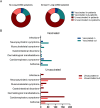SARS-CoV-2 vaccination influence in the development of long-COVID clinical phenotypes
- PMID: 39901510
- PMCID: PMC11869074
- DOI: 10.1017/S0950268825000093
SARS-CoV-2 vaccination influence in the development of long-COVID clinical phenotypes
Abstract
Although SARS-CoV-2 vaccination reduces hospitalization and mortality, its long-term impact on Long-COVID remains to be elucidated. The aim of the study was to evaluate the different development of Long-COVID clinical phenotypes according to the vaccination status of patients. Clinical and demographic characteristics were assessed for each patient, while Long-COVID symptoms were self-reported and later stratified into distinct clinical phenotypes. Vaccination was significantly associated with the avoidance of hospitalization, less invasive respiratory support, and less alterations of cardiopulmonary functions, as well as reduced lasting lung parenchymal damage. However, no association between vaccination status and the development of at least one Long-COVID symptom was found. Nevertheless, clinical phenotypes were differently associated with vaccination status, as neuropsychiatric were more frequent in unvaccinated patients and cardiorespiratory symptoms were reported mostly in vaccinated patients. Different progression of disease could be at play in the different development of specific Long-COVID clinical phenotypes, as shown by the different serological responses between unvaccinated and vaccinated patients. A higher anti-Spike (S) antibody titre was protective for vaccinated patients, while it was detrimental for unvaccinated patients. A better understanding of the mechanism underlying the development of Long-COVID symptoms might be reached by standardized methodologies and symptom classification.
Keywords: COVID-19; PASC; anti-S antibodies; mRNA vaccine; post-COVID-19 syndrome.
Figures




Similar articles
-
Seroresponse to SARS-CoV-2 Vaccines among Maintenance Dialysis Patients over 6 Months.Clin J Am Soc Nephrol. 2022 Mar;17(3):403-413. doi: 10.2215/CJN.12250921. Epub 2022 Feb 10. Clin J Am Soc Nephrol. 2022. PMID: 35144972 Free PMC article.
-
Effect of timing of casirivimab and imdevimab administration relative to mRNA-1273 COVID-19 vaccination on vaccine-induced SARS-CoV-2 neutralising antibody responses: a prospective, open-label, phase 2, randomised controlled trial.Lancet Infect Dis. 2025 Jan;25(1):52-67. doi: 10.1016/S1473-3099(24)00421-3. Epub 2024 Sep 2. Lancet Infect Dis. 2025. PMID: 39236733 Clinical Trial.
-
SARS-CoV-2 Virus-Like Particle Neutralizing Capacity in Blood Donors Depends on Serological Profile and Donor-Declared SARS-CoV-2 Vaccination History.Microbiol Spectr. 2022 Feb 23;10(1):e0226221. doi: 10.1128/spectrum.02262-21. Epub 2022 Feb 16. Microbiol Spectr. 2022. PMID: 35171006 Free PMC article.
-
mRNA vaccine-induced SARS-CoV-2 spike-specific IFN-γ and IL-2 T-cell responses are predictive of serological neutralization and are transiently enhanced by pre-existing cross-reactive immunity.J Virol. 2025 Mar 18;99(3):e0168524. doi: 10.1128/jvi.01685-24. Epub 2025 Jan 31. J Virol. 2025. PMID: 39887249 Free PMC article.
-
COVID-19 Cases and Hospitalizations by COVID-19 Vaccination Status and Previous COVID-19 Diagnosis - California and New York, May-November 2021.MMWR Morb Mortal Wkly Rep. 2022 Jan 28;71(4):125-131. doi: 10.15585/mmwr.mm7104e1. MMWR Morb Mortal Wkly Rep. 2022. PMID: 35085222 Free PMC article.
References
-
- WHO Coronavirus. WHO Coronavirus (COVID-19) Dashboard. https://covid19.who.int (accessed December 20, 2023).
-
- Pasculli P, Zingaropoli MA, Dominelli F, Solimini AG, Masci GM, Birtolo LI, et al. (2024) Insights into long COVID: Unraveling risk factors, clinical features, radiological findings, functional sequelae and correlations: A retrospective cohort study. The American Journal of Medicine 18S0002–9343(24)00569–2. 10.1016/j.amjmed.2024.09.006. - DOI - PubMed
MeSH terms
Substances
LinkOut - more resources
Full Text Sources
Medical
Miscellaneous

